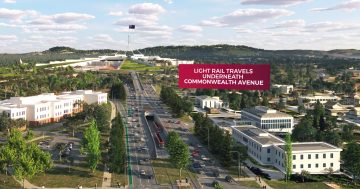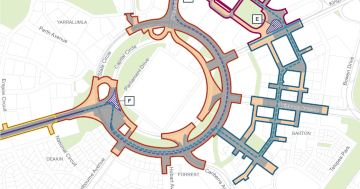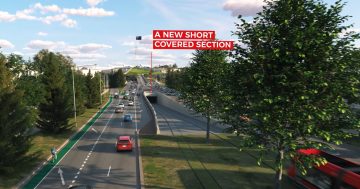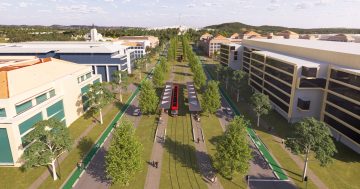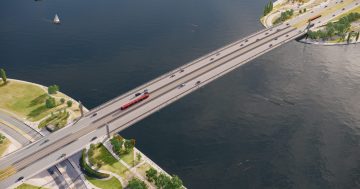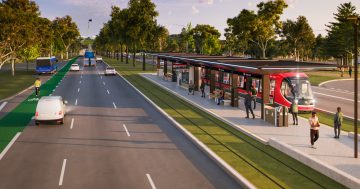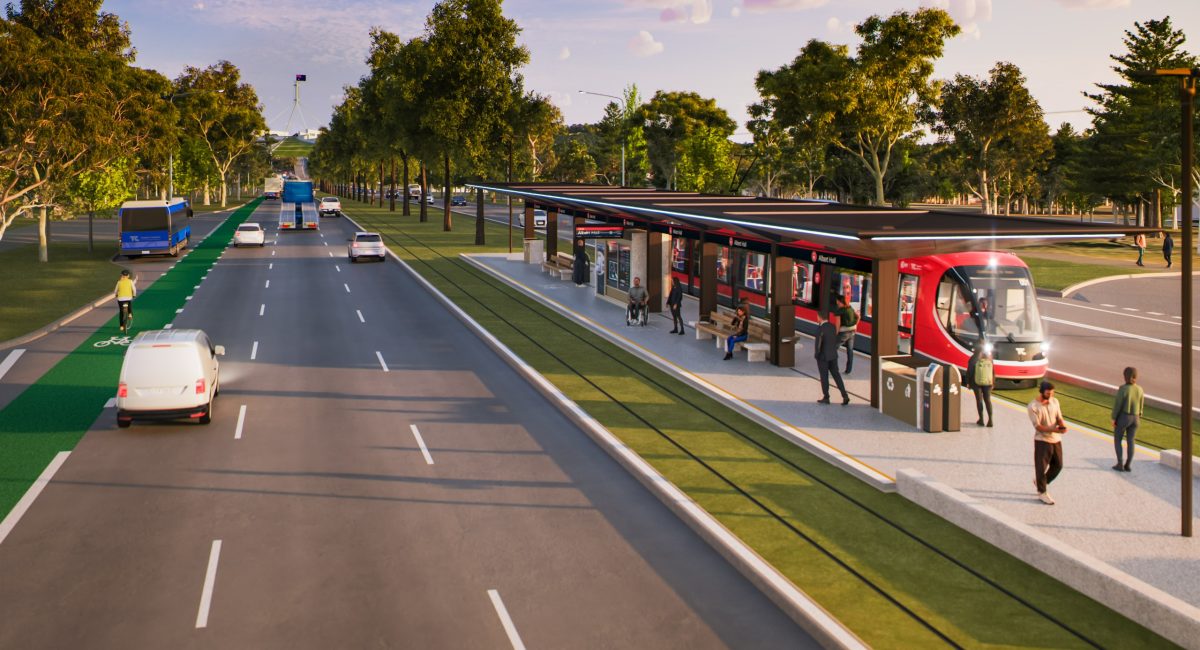
New treescape: An artist’s impression of the proposed Albert Hall Stop. Image: ACT Government.
An alternative light rail route for Stage 2B has been proposed to avoid wreaking havoc on the heritage values of the National Triangle and the Griffins’ design for the national capital.
Former government planner and president of the Kingston Barton Residents Group, Richard Johnston, has lodged a submission to the draft Environment Impact Statement consultation for Stage 2B, which closes on 5 September.
Mr Johnston says the two light rail Stage 2B route options in the draft EIS would both be disastrous for the heritage and landscape character of the National Triangle, including important views from Parliament House.
His submission says a new, less damaging route must be considered.
Mr Johnston proposes a route that would save the 100-year-old Commonwealth Avenue median and verge trees planted by Charles Weston, and those on a 1300-metre stretch of the inner verge of State Circle from about Kings Avenue to Adelaide Avenue.
New plantings of cedar and Chinese elm are proposed for Commonwealth Avenue, but a 20-metre deep band of trees, including gang-gang cockatoo breeding trees, on State Circle would not be replaced, with this area becoming road surface.
Mr Johnston’s route would also save trees along the non-preferred Barton route on Macquarie Street, Bligh Street and National Circuit, all of which would need to be widened. New plantings are proposed, but on narrower verges.
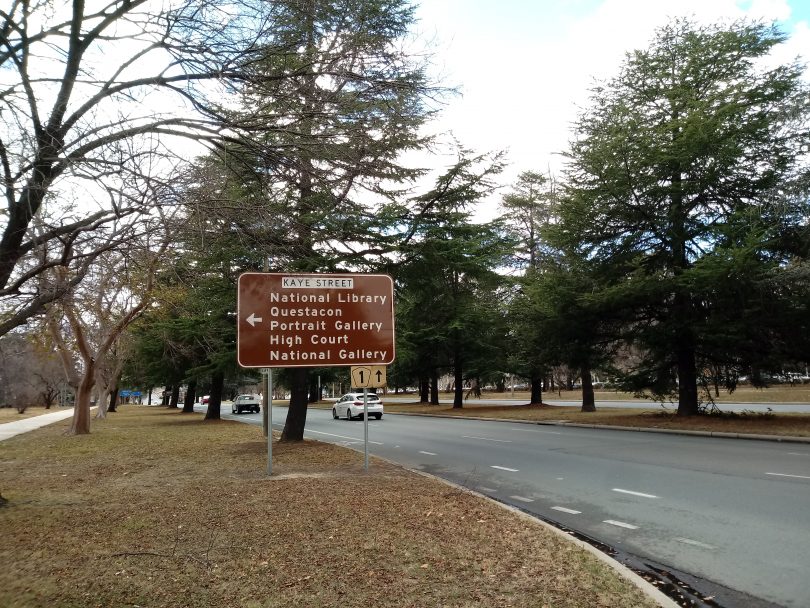
The Weston-era trees on Commonwealth Avenue trees that will go.
Mr Johnston proposes the route leave Commonwealth Avenue at King Edward Terrace, travel through the Langton Crescent carpark to King George Terrace, then head along King George Terrace to Kings Avenue, and then up to State Circle, either in the median or the north-western verge where there are minimal trees.
He says it would be possible to take the route around the inside verge of State Circle from Kings Avenue to opposite Brisbane Avenue and from there transition up to Capital Circle, through a relatively lightly treed area, and then on to Adelaide Avenue.
The advantages of this route would be a reasonably short route and mainly level running; reasonable access to national institutions and employment areas; no significant loss of trees on Commonwealth Avenue, State Circle and in Barton; and no major traffic disruption to Barton and difficult transitions between Commonwealth Avenue and State Circle, State Circle and Adelaide Avenue.
Mr Johnston said the ACT Government turned its back on previous route options when it plumped for the two alignments in the draft EIS to avoid repeating the EIS process if its preferred State Circle choice did not work out.
“This may have been the most convenient outcome for the ACT Government, but it does not remove its obligation to consider further alternatives in the event that the impacts associated with their preferred option are unacceptable, particularly the effects on Commonwealth Avenue, which is clearly the case based on the Heritage Report,” he says.
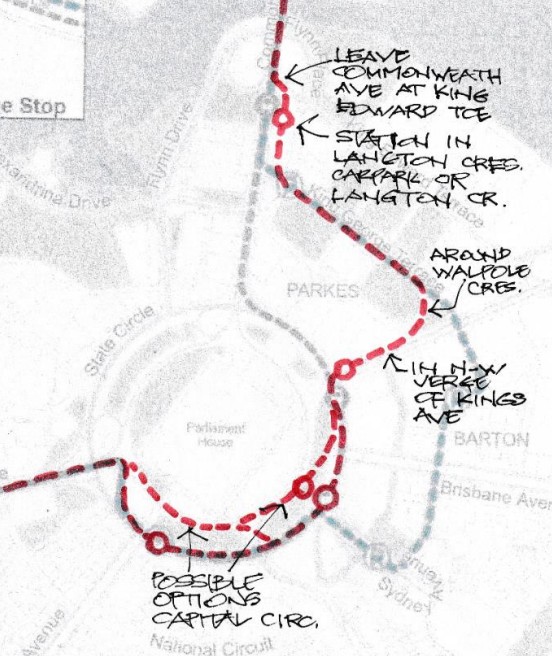
Mr Johnston’s alternative route. Image: Richard Johnston.
Mr Johnston says the draft EIS details the major impacts the two routes would have on the National Triangle but makes no attempt to provide any less damaging alternatives.
The Heritage Report says “the historic trees and plantings of the Project area are fundamental to expressing the heritage values of Canberra’s central area as a ‘historic, designed urban landscape’ of national significance”.
“Together, the impacts on the heritage places associated with the State Circle East alignment will extensively alter the historic character and geometry of Canberra’s highly significant planned landscape, changing the expression of the designed city plan prepared by the Griffins and implemented by subsequent custodians, which forms the underlying structure for the entire expression of the unique and iconic urban design of Canberra,” it says.
Mr Johnston says this assessment was not new, quoting a 2021 GML Heritage report prepared for Major Projects Canberra, Landscape Heritage Advice for Commonwealth Avenue, which recommends retaining the Weston-era plantings.
“There has been one design intent for Commonwealth Avenue, implemented and interpreted by different custodians over time,” the report says.
“Current and future custodians, as well as those making changes to the avenue, should make design choices informed by its heritage values, which will conserve and celebrate these values for future generations.”
“But will our current politicians, planners and designers rise to that challenge?” Mr Johnston’s submission asks.












